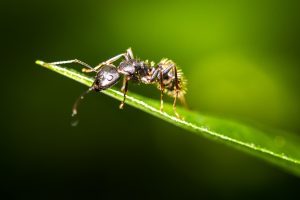MGG’s Ryan Anderson covers how to rid your yard of the most loathed pest naturally.
From the questions we field at MGG, we aren’t surprised that the National Pest Management Association (NPMA) reports ants as the number one nuisance pest in the US.
For indoor pest control, MGG provides Integrated Pest Management (IPM) resources that minimize access to food, water, and shelter. Many ants, however, live in colonies or nests outside the house and may require outdoor treatment to prevent further indoor infestations.
When planning to control ants outside, MGG encourages you to first consider whether control is necessary. Ant nests located far away from your home likely pose no threat to your comfort indoors. In fact, these ants benefit the health of your lawn and garden by tunneling and aerating your soil, collecting and decomposing dead insects for organic fertilization, and, sometimes, preying on garden pests.
If your toleration level for these beneficial insects runs low or you detect a nest nearby your house in or under logs, boards, stumps, tree roots, or rocks, DO NOT GRAB THE RAID and use these methods for non-toxic control:
- Prevention: IPM always starts with prevention. The most common ant species found indoors of Carpenter, Odorous, and Pavement tend to nest near high moisture conditions. Carpenter ants, in particular, excel in moisture-damaged wood. To prevent these colonies from establishing, circle the perimeter of your house or apartment building and remove leaves, mulch, and tree branches from the foundation. Finally, store firewood or other lumber in dry and elevated spaces to increase air circulation.
- Bait the ants with Boric Acid: Any visible ant scouts and brings food back to its nest to nourish the queen and others. Baiting these scouts with something toxic to them, will eventually get to the queen and kill the colony. Fortunately, Boric Acid, or its crystalized form of Borax, offers a low-toxicity bait option that harms ants, but not humans, pets, or other wildlife. Mixing Borax with something sweet like jelly will attract the ants and it will work its way through the ant colony from there.
- Take out the nest with Diatomaceous Earth: For many years, pest control products have harvested these fossilized, microscopic algae (called diatoms) to kill invertebrates. Each diatom has a hard, silicon dioxide based exoskeleton that abrades the outer shells of insects and initiates water loss. Diatomaceous earth (DE) continues to mechanically extract water-protecting fats and oils from the insect, until the insect eventually dehydrates and dies. For most effective control with DE, shovel the top of the ant hill and use a stick to stir and break up the network of tunnels in the ant hill. Following, proceed to add and mix in the DE to ensure it comes in contact with the ant colony, targeting the queen. Make sure you purchase DE products without synthetic insecticides. DE labeled “food grade” is 100% DE and non-toxic to humans.
Smothering the hill with boiling soapy water or surrounding it with corn starch has, also, shown to be effective. Time these ant control alternatives during the night when most ants return to the nest. After taking out a nest in your lawn, remember to fill the hole with an overseed.
Finally, AVOID SPRAY PESTICIDES AT ALL COSTS! These products both harm beneficial insects and could scatter the nest resulting in more colonies.
For more questions regarding ant control both indoors and out, take a look at our Ant Factsheet.

